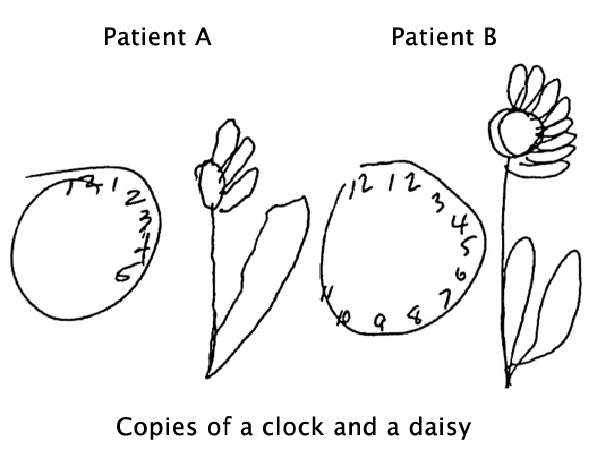Most readers of this blog are probably familiar with "unilateral neglect," one of several behavioral manifestations of brain damage to the parietal lobe. Perhaps fewer readers are aware of other findings from unilateral neglect patients which are often omitted from classic descriptions of this syndrome.
First, the obligatory illustration of unilateral neglect; here's what happens when you ask a patient with right parietal lobe damage to copy a simple drawing of a clock and a flower:

Patients with this "unilateral" or "hemispatial" neglect are able to describe only those parts of a mental scene which are represented in undamaged cortex, whether that mental scene is being received from the environment (as in copying a drawing) or being recalled or imagined from memory. Interestingly, asking subjects to mentally or physically rotate the imagined or perceived images can allow patients to describe the previously-neglected portion of the scene. Such early work was instrumental in the development of the standard textbook story about parietal cortex: it's important for spatial perception.
But a newer story about the parietal cortex describes it as being important in "perception for action." Indeed, an often-neglected aspect of unilateral neglect is also compatible with this theory. As described by Robertson, when patients are asked to find the middle of an object, the typical tendency for unilateral neglect patients to point at a noncentral location is no longer observed if they are asked to pick up the object at its central location.
Theories of the parietal cortex have continued to develop based on evidence from healthy populations, in whom the parietal lobe has demonstrated importance in much more domain-general forms of attention. One example is in the "binding problem" (which is basically the question of how you know you're looking at a red square when both "red" and "square" are initially processed in disparate parts of the visual processing stream), for which the parietal cortex seems very important. Other work indicates the parietal lobe is important for maintaining information over time in the absence of perceptual input, in task-switching (even on nonspatial tasks), in attention, in representing numerical magnitudes, and in representing time. Since most cognitive tasks require a motor response, it is possible that some findings of parietal activity reflect motor preparation or intention (see also this), but the idea that parietal cortex has a more domain-general role is increasingly accepted.
The best review of the parietal cortex I've seen yet clearly notes the apparent discrepancy between the classic unilateral neglect symptom and the more domain-general roles recently advocated for parietal cortex. However, a closer look at unilateral neglect indicates that the symptoms are not merely spatial in nature, and that the discrepancy in findings may be more apparent than real.
The following facts are described in Robertson's review of unilateral neglect and Husain & Rorden's review of non-spatial components to neglect:
1) Both right and left parietal damage is sufficient for generating hemispatial neglect, but patients with left-sided damage tend to recover quickly (sometimes, presumably, prior to cognitive testing).
2) Additional brain damage to the contralateral prefrontal hemisphere can sometimes remediate unilateral neglect, perhaps indicating interhemispheric competition
3) Patients with chronic unilateral neglect (most often with damage to the right parietal lobe) also show deficits in maintaining attention, and manipulations which improve alertness also ameliorate their unilateral neglect. In addition, the best predictor of post-insult recovery is the impairment of attentional systems (even better than how much brain damage was sustained!).
4) inferior frontal damage is also sufficient for generating hemispatial neglect, indicating both more frontal involvement in this disorder than commonly recognized and more consistency with other literature indicating a tight integration between frontal and parietal circuits.
5) unilateral neglect patients show deficits in both attentional blink and oddball paradigms, indicating nonspatial difficulties with selective attention.
Husain & Rorden suggest that neuropsychology's typical emphasis on double dissociations may have led to the ommission of these findings from the unilateral neglect literature. A more complete picture of this form of brain damage indicates that it is far from a selective deficit in spatial processing. Instead, parietal damage seems to cause a host of issues, and perhaps the most central among them are deficits in nonspatial attention. It is the attentional deficits which predict recovery, and the lateralized deficicts that do occur can be ameliorated with attentional manipulations as simple as cueing subjects to engage attention by warning them about an upcoming stimulus.

Thanks for the alerting to this new review by Husain and Rorden; I hadn't yet seen or heard of it. And, in your review you mention a Pascual-Leone paper on temporal processing difficulty in neglect - many years ago I believe Husain was the first to show such deficits.
Discovering the fractionalization of parietal lobe functions will really resolve some of the last islands of mystery in the cortex...
I loved your Stroop post last week too - good work! That "famous" McLeod paper your referred to came out my first year in grad school. We were all floored at the extent of the coverage, and our profs were pretty excited by the quality of the review and suggestions that came out of that paper.